FIFTY YEARS OF FERRARI
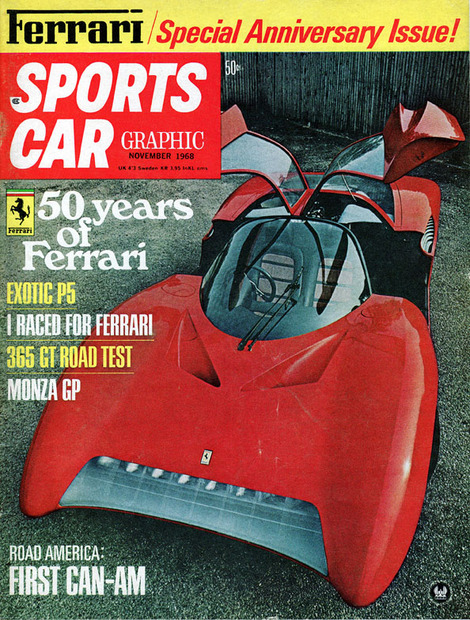
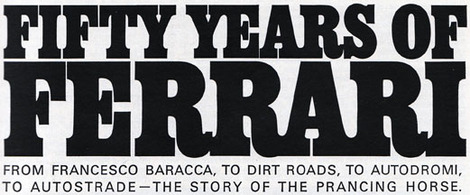
*by Ted West * * photos/Hans Tanner Collection/Bernard Cahier *
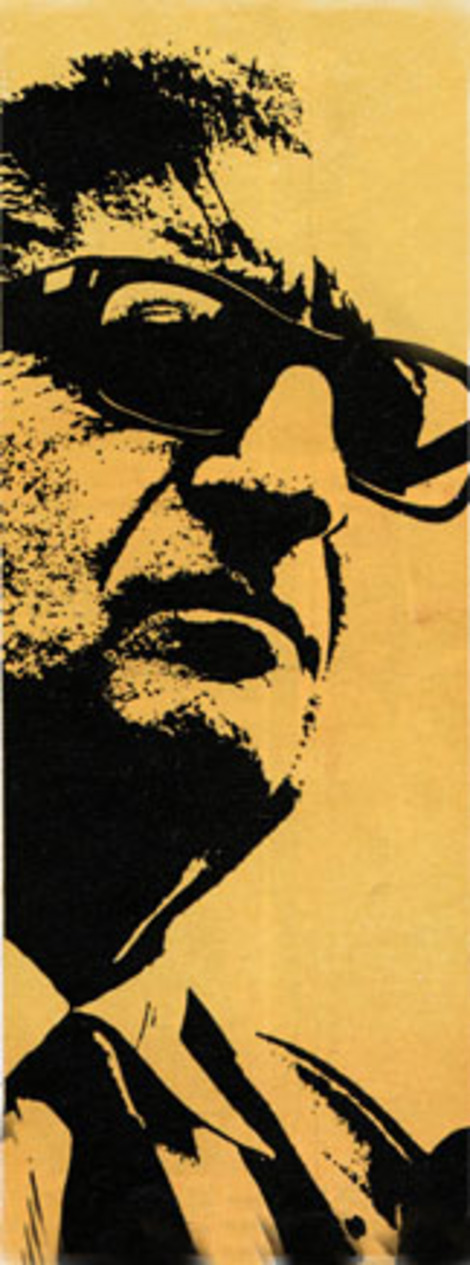
IT WAS EXACTLY FIFTY YEARS AGO THIS MONTH. Enzo Ferrari had waited all day in the front rooms of Fait Motor Co. hoping for a chance to speak to head engineer Diego Soria, hoping the letter of introduction he had brought from his wartime artillery colonel would make some difference, hoping for a job. But when he finally got into Soria's office, he was told politely but firmly that there was no possibility of a job for him at Fiat, and that as much as it would like to, Fiat Motors could not provide positions for every destitute wartime invalid who happened into their office. And so Enzo Ferrari went back out into the cold winter of 1918 and walked through the streets of Turin until he reached the city's Valentino Park. Fifty years ago, yhe man who would become perhaps the greatest automotive impresario of the century, sat on a lonely bench in the middle of Valentino Park with little money, no job, no prospects, and despaired.
Ferrari had recently lost his father and only brother from illnesses, and Ferrari himself had almost died of an illness contracted during the last year of the war. He had been so seriously ill, indeed, that the doctors had consigned him to a section of the Balogna medical corps area set aside for "terminal" cases, but through an assertion of the will power which would figure so prominently innearly everything Enzo Ferrari later accomplished, he somehow managed to recover.
A few months later Ferrari had talked to Soria, had been refused a position, and now here he sat in the snow-covered park- alone, freezing cold, deeply depressed. He would return to that bench several times in his life, in days when Ferrari victories filled the headlines of the world's automotive press, when Ferrari cars filled the garages of the world's rich, when the name itself signified nothing more and nothing less than the ultimate expression of contemporary automotive ingenuity and perfection. He would remember this lonely bench, for it was the symbol of all the worst and the best that would befall him; froma hopeless moment fifty years ago, to moments years later when his cars were beating the world. This bench was the symbol Enzo Ferrari's life with automobiles.
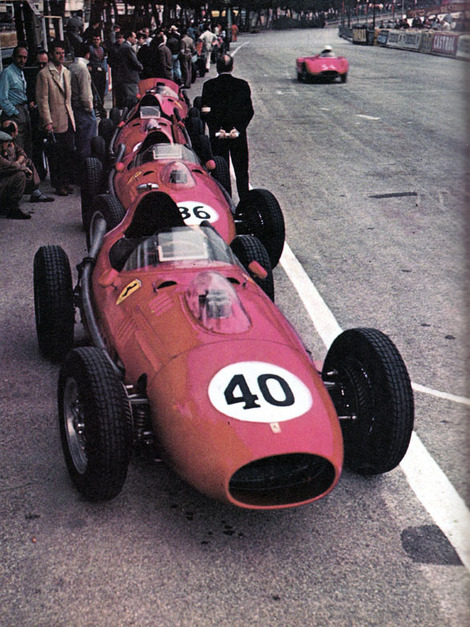
As a boy, Ferrari had three distinct ambitions - to be an opera singer, a sports journalist, and a racing driver. He accomplished two of the three goals, though a defective ear for music robbed him of the third. Ferrari was born in Modena, Italy, on February 18, 1898, to a modest middle-class family. His father ran a small but successful structural steel concern and on weekends took young Enzo to the many auto races held in the area. From the beginning, that strange, loud, greasy phenomenon known as the internal combustion engine fascinated the boy. As his father's business continued to grow, it moved into the area of automobile repairs, and working for his father, Enzo got his first exposure to the practical world of mechanics. All the while, he and his father went to the races and saw drivers as Nazzarro and a man named Lancia wheel their mighty racers through the dusty dirt roads of the region. And the more he saw and learned, the more fascinated he became.
Years later, in the spring of 1919, Ferrari's determination to work with automobiles made him continue his search after the unhappy experience with Fiat. He applied for and received a job with a mechanic in Turin, who was in the business of stripping wartime trucks and selling the chassis to a Milanese coach-builder. Enzo tested the chassis and mechanical components before sending them to Milan to have sporting roadster bodies attached. Since in the wake of the war new sporting machinery was practically non-existent, these cars were very much in demand. While working at this positin, Frrari began to meet many of the Turinese racing people and succeeded through his new connections in getting hired at a much better salary by the Milanese "Costruzioni Meccaniche Nazionali," or CMN, auto company - first as a rest driver, then as a race driver.
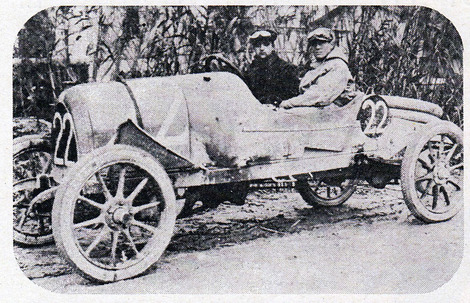 Ferrari at the wheel of his CMN for the 1919 Targa. In this, his first major race, Ferrari was seriously delayed by the President of Italy.
Ferrari at the wheel of his CMN for the 1919 Targa. In this, his first major race, Ferrari was seriously delayed by the President of Italy.
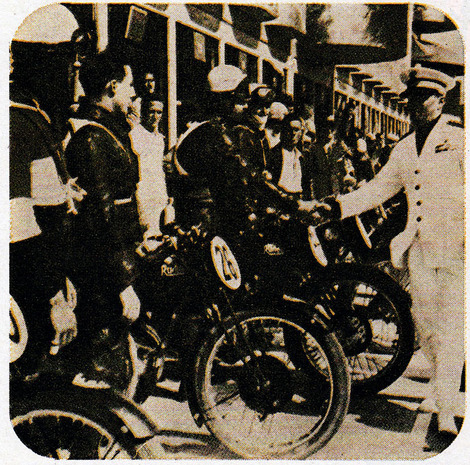 The Scuderia Ferrari motorcyclists at 1934 Coppa Del Mare, from left, A ldrighetti, Nazzaro, Pigorini, and Colabattisti. Ugo Leonardi, President of the Motorcycle Racing Club of Italy, shakes Pigorini's hand. Pigorini won the 350-cc category that day and the 350-cc national championship that year. Note the prancing horse on the front fender of the cycles.
The Scuderia Ferrari motorcyclists at 1934 Coppa Del Mare, from left, A ldrighetti, Nazzaro, Pigorini, and Colabattisti. Ugo Leonardi, President of the Motorcycle Racing Club of Italy, shakes Pigorini's hand. Pigorini won the 350-cc category that day and the 350-cc national championship that year. Note the prancing horse on the front fender of the cycles.
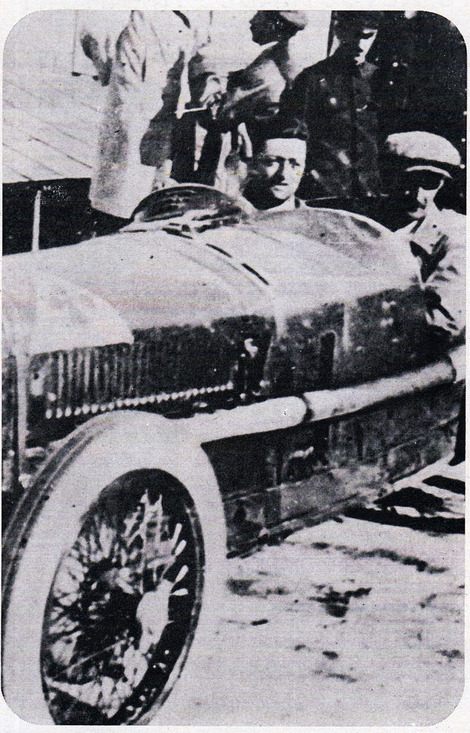 Ferrari with Bazzi in an Alfa P2 at the 1924 French Grand Prix. Though he himself did not drive due to ill healt, the organization for which he was largely responsible severely defeated Fiat at this race and caused them to go through with their long-considered withdrawal from racing.
Ferrari with Bazzi in an Alfa P2 at the 1924 French Grand Prix. Though he himself did not drive due to ill healt, the organization for which he was largely responsible severely defeated Fiat at this race and caused them to go through with their long-considered withdrawal from racing.
It was with CMN that Ferrari got his first real experience racing. The company provided him with a competition car for the 1919 Targa Florio and he set off south with his co-driver for the big race. It was an eventful introduction to the sport. Driving through the Abruzzi Mountaains in a blizzard, the two were set upon by wolves and had to fire their pistols to scare them away. As if that wasn't bizarre enough, when Ferrari finally got to the Targa he got off to a good start, only to be halted with two other competitors at mid-rac and forced by the Carabinieri to wait for Italian President Vittorio Emanuele Orlando to make a long speech to the local citizenry in the middle of the road course passing through Campofelice. Even after the interminable speech. Ferrari and the two other racers were not allowed to pass through, but had to follow the President's motorcade at a respectful creep, sitting bolt upright in their open roadster. When they finally got past and finished the race, they were so overdue that the officials and the crowd had gone home. "Maybe next year," Ferrari thought, but CMN was unimpressed. The next year, though, he was offered a car by his new employers at Alfa Romero and drove south again, hoping for a few less wolves and one less political speech. This race proved more fortunate, with Frrari placing his 4.5 Alfa an excellent second ahead of his famous teammate (and opera star) Giuseppe Campari. From there on Ferrari began to make guite a name for himself as a driver. He won at Mugello and the Aosta Grand St. Bernard hill climb in 1920, took second at the 1921 Mugello race, won Savio in 1923, and the significant Coppa Acerbo in 1924.
In the meanwhile, another of Ferrari's talents began to evidence itself around Alfa. The company had been looking for first-class racing people in order to build a major competition effort, and Ferrari's energy and enthusiasm recommended him as an ideal recruiter. First he got Luigi Bazzi away from Fiat, which at the time was an important racing group, aand then later, took the brilliant Vittorio Jano, who had also been working at Fiat. Results were not slow in arriving. With the two ex-Fiat men designing and Campari, Antonio Ascari (Alberto Ascari's father), and Sivocci testing, odd-looking new cars began appearing on roads around the plant. Something major was afoot, and nobody knew just how major it was until the season of 1924, when Alfas began to annihilate all opposition. Depending both on the 1923 "R.L.S." and the brand new Jano-designed P2, Alfa first beat Mercedes at Pescara. Enzo Ferrari driving, then wiped out Fiat at the French Grand Prix, and was in large part responsible for Fiat's total withdrawal from racing.
All the while Ferrari's ability as an organizer was becoming more and more evident. He was still bothered with illness and was unable to drive as often as he might have liked, but on the occasions when he drove, he continued to do well. In 1924 he won the Gargano hill climb and won again at Savio, two places ahead of a small, wiry, new driver named Nuvolari. He also won at Polesine and Pescara and was second at the Pozzo Circuit.
It was during this long string of victories that Ferrari adopted his famous emblem of the prancing horse. At the 1923 Savio event, Ferrari's 3-liter car had so completely dominated the race against much larger machines that he was an immediate sensation. In the crowd was the father of Francesco Baracca, one of Italy's greatest air aces in WWI. When Baracca was shot down late in the war, his prancing horse emblem had been sent to his parents, and they offered it to Ferrari in commemoration of his skill at Savio that day. Ferrari gratefully accepted the gift and made it his own emblem ever since.
Prior to 1929, however, the prancing horse emblem was only on one car at a time - Enzo Ferrari's personal race car. Then one night after Alfa Romero announced its withdrawal from racing. Enzo Ferrari and three friends got together to discuss private racing teams, and the famous "Scuderia Ferrari" was formed. The new concern moved to Ferrari's home town of Modena, but ties with Alfa were still extremely close. He would be distributor for the Emilia-Romagna and Marche provinces and service center for privately owned Alfas, as well as being a well-subsidized racing arm of the factory. Suderia Ferrari's competition came in the early years from Bugatti and Maserati, with Mercedes begining to show more interest as German world consciousness began to increase. Later the Germans would dominate competition, but it took them several years and a major governmental subsidy from the Nazis to overtake the tiny, but ingenious, Italian racing groups.
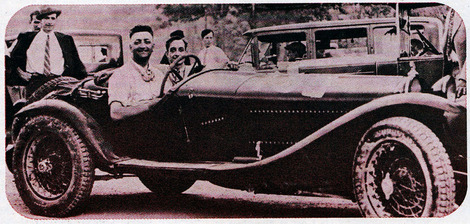 Ferrari at the wheel of an Alfa 1750 with rider Vallisi after winning his last race, the 1932 Bobbio-Penice event. At this time Ferrari's only son, Dino, was born and the new father resolved to give up driving in favor of his responsibilities as a parent. Dino Ferrari, a gifted young engineer, died of a nephritis virus in 1956.
Ferrari at the wheel of an Alfa 1750 with rider Vallisi after winning his last race, the 1932 Bobbio-Penice event. At this time Ferrari's only son, Dino, was born and the new father resolved to give up driving in favor of his responsibilities as a parent. Dino Ferrari, a gifted young engineer, died of a nephritis virus in 1956.
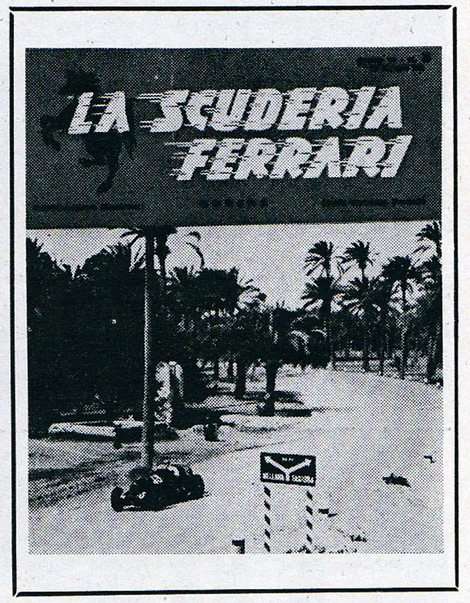 Cover of the May 19, 1936 issue of Ferrari's magazine, "La Scuderia Ferrari," cover photo shows Brivia's Alfa at the Tripoli Grand Prix, where the Italian cars were severely handicapped with tire trouble. Auto Unions took first and second, Mercedes third and fourth, with Pintacuda fifth in the first Alfa. It was the beginning of the end for the Alfas, as the Germans budgets began to tell.
Cover of the May 19, 1936 issue of Ferrari's magazine, "La Scuderia Ferrari," cover photo shows Brivia's Alfa at the Tripoli Grand Prix, where the Italian cars were severely handicapped with tire trouble. Auto Unions took first and second, Mercedes third and fourth, with Pintacuda fifth in the first Alfa. It was the beginning of the end for the Alfas, as the Germans budgets began to tell.
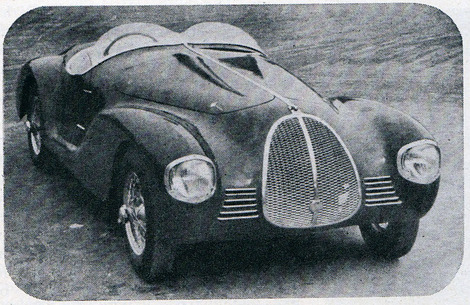 The so-called "Auto-Avio Construzioni 815," as it appeared for the 1940 Gran Premio di Brescia. This 1500-cc machine, of which there were two, driven by Alberto Ascari and Marchese Lotario Rangoni Machiavelli, was truly the first "Ferrari," though under terms agreed to by Ferrari and Alfa Romero, Ferrari could not officially give his name to a car for four years after his release.
The so-called "Auto-Avio Construzioni 815," as it appeared for the 1940 Gran Premio di Brescia. This 1500-cc machine, of which there were two, driven by Alberto Ascari and Marchese Lotario Rangoni Machiavelli, was truly the first "Ferrari," though under terms agreed to by Ferrari and Alfa Romero, Ferrari could not officially give his name to a car for four years after his release.
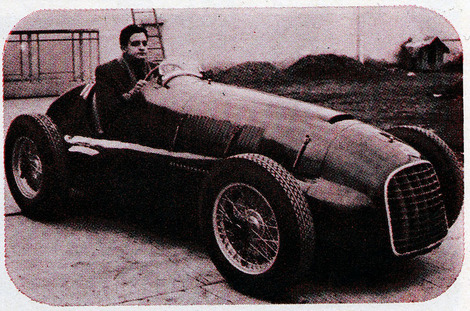 The post war Tipo 125 1500-cc supercharged Grand Prix car being driven by Dino Ferrari. This was among the first cars built by the new Modena company.
The post war Tipo 125 1500-cc supercharged Grand Prix car being driven by Dino Ferrari. This was among the first cars built by the new Modena company.
In the meantime, Alfa Romeros out of Scuderia Ferrari were the cars to beat. In 1930, the team depended on 1750-cc P2's for most of the season, with Nuvolari winning the Mille Miglia and Varzi bettering the Targo Florio record by no less than 20 minutes. In 1931, Mercedes fielded a team of 7-liter cars and caught Ferrari off guard. In a frantic last minute rush he put together a 2.3 liter Alfa, which led the tighter sections of that year's Mille Miglia with ease, but tire troubles and sheer brute strength of the Mercedes ultimately gave Germany the race. Realizing he would need much more power, Ferrari put two 1750-cc engines together and the resulting 3.5-liter 12 cylinder won the Grand Prix of Monza, beating Bugatti (4.9-liter) and Maserati easily. Mercedes, however, did not run at Monza that year, so the Mille Miglia loss went unavenged. But the scuderia was not taking any chances on their next meeting with the Germans. They had drawn star driver Carraciola away from Mercedes for the 1932 season, and Jano was completing work on the new 2650 Alfa P3.
Even without the services of the new car, through, a large group of much-improved 2.3-liter cars made a shambles of the 1932 Mille Miglia. Borzacchini arrived first, with six Alfas behind him, a lonely Lancia, and then four more Alfas in a row. Eleven of the first 12 places made the people in Modena quite happy - particularly as full teams of Bugatti (among them the 4.9-liter cars), Lancia and Mercedes (7-liters) had been entered. The 2.3 Alfa went on to win the 24 hour races at Spa and LeMans, the Targa, and the Grands Prix of Finland and Mareilles that year. The P3 then took over for most of the season, and in it Nuvolari won the Grand Prix of France, the Coppa Acerbo, the Grand Prix of Avellino, Montenero, and Monte Carlo; with Carraciola taking the Eifelrennen, Monza, and the German Grand Prix.
1933 was another strong year for the scuderia. Nuvolari won the Mille Miglia and lost a narrow battle with Vazi's Bugatti at Monte Carlo when his engine blew on the last lap. Nuvolari went on to win Alessandria, LeMans, the Eifelrennen and Nimes, before leaving the scuderia for Maserati when it seemed the other team had a faster machine. This turned out to be a mistake, though, as the Ferrari proved faster at Monza, Fagioli throughly beating Nuvolari in this race which took the lives of Campari and Borzacchini, Fagiolo also won Pescara; with Louis Chiron, present day official starter at Monte Carlo, winning at San Sebastian and Masryk for Ferrari.
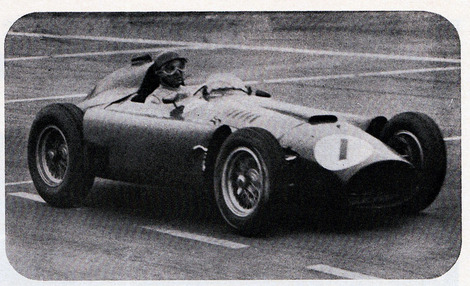 The 1956 World Championship combination of Juan Fangio and Lancia-Ferrari winning Silverstone. Characteristic side-tanks distinguish car, which was handed over to Ferrari after Ascari's death caused Lancia to with draw from racing.
The 1956 World Championship combination of Juan Fangio and Lancia-Ferrari winning Silverstone. Characteristic side-tanks distinguish car, which was handed over to Ferrari after Ascari's death caused Lancia to with draw from racing.
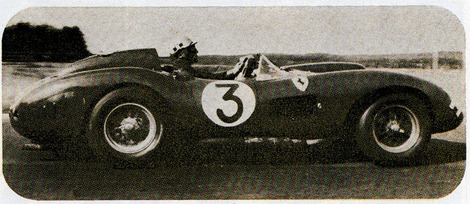 Tipo 412 twin-cam 4.3-liter in the hands of Musso at the Swedish Grand Prix. The cars placed 2nd and 4th in this event and had tough competition from Maserati all year, though Ferrari eventually won the Manufacturers' Championship.
Tipo 412 twin-cam 4.3-liter in the hands of Musso at the Swedish Grand Prix. The cars placed 2nd and 4th in this event and had tough competition from Maserati all year, though Ferrari eventually won the Manufacturers' Championship.
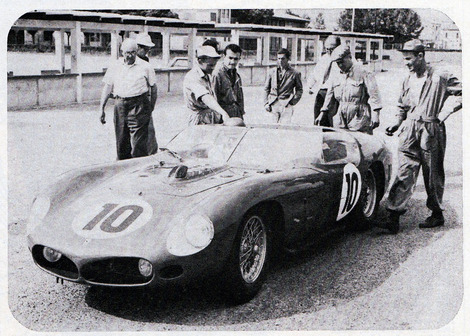 The 1961 version of the Tipo 250 Testa Rossa. This car won Sebring, LeMans, the Targa, Pescara, and was second at the Nurburgring - went on to win Sebring in 1962. Also 1961 World Manufacturers' Champion.
The 1961 version of the Tipo 250 Testa Rossa. This car won Sebring, LeMans, the Targa, Pescara, and was second at the Nurburgring - went on to win Sebring in 1962. Also 1961 World Manufacturers' Champion.
Nuvolari had clearly misjudged the Maserati and wished to be back in an Alfa for the 1934 Mille Miglia. He was given an older 2.3-liter after some backroom solicitation with his friend Jano, but Varzi (now back from Bugatti) had the number one car. This was to prove one of the classic Mille Miglias, with the lead changing several times. First Varzi led, using the extra power of his bored-out 2.6-liter engine to good advantage, then Nuvolari moved up when Varzi's clutch began to slip, but towards the end of the race Ferrari gave Varzi the weather report up ahead during a pit stop and Varzi decided on rain tires, which won him the race.
1934 saw a very serious entry from Mercedes and Auto Union, but the need for development made it a difficult year for the Germans and a very successful one for Ferrari. The scuderia won 12 major victories, including the Targa, Monaco, and the German and French Grands Prix. 1935 was also fairly successful, but the sheer might of the German cars was beginning to tell, and the only races of truly major importance that the scuderia won were the Mille Miglia and the Targa.
During these years, Ferrari also fielded a highly successful motorcycle racing team. Headed up by Giordano Aldrighetti and his close friend Aldo Pigorini, the team ran very quick Rudge cycles, and its record was nearly as impressive as the record of the auto racing branch. In 1932, Aldrighetti won both 250-cc and 350-cc classes wherever he went, including the Coppa del Mare, the Circuito dei Tre Monti, and the Piemonte and Avellino races. He also won the gold medal at the 1932 Six Day International enduro. In 1933, Ferrari moved him up to the bigger 500-cc class, where he won the Italian Championship. Pigorini won the Italian Championship at 350-cc's in 1934, after winning many other victories spread over the previous year.
Also in this period, Ferrari achieved his second ambition of becoming a sports writer. He published several numbers of his own magazine, which was called, logically enough, "La Scuderia Ferrari." Devoted entirely to auto racing (and, conveniently, to motorcycling if the occasion should arise) there was no lack of material to discuss - indeed, almost every race of any significance at all was swept by the scuderia's Alfa's, so writing the magazine must have been an unusually pleasant task.
As the German cars began to develop their reliability, though, it was only a matter of time before they would thoroughly dominate motor racing. Their budgets were practically unlimited, and from 193 through 1940 they got the inevitable results. The scuderia managed to win its own, the Mille Miglia during those years, but was unable to win much else. At the end of 1938, Alfa decided to build an all-out factory effort to combat the Germans, and the old scuderia was no more. In 1940, however, the Gran Premio di Brescia was run in spite of the war, and two very fast new cars led it - although in racing each other for the win both expired. The cars called "815"s, were extremely modern 8-cylinder, 1500-cc machines with graceful bodies by Touring, and had a somehow familiar hood ornament composed of a prancing horse. Officially, the cars were called Auto-Avio Costruzioni "815"s, because Alfa had secured an agreement from Ferrari that he would not make a car under his name for four years. But to the cognoscenti, there was finally a car named Ferrari.
The war, of course, brought competition to a halt. Indeed, by its end, the war had brought practically all of Italy to a halt, but the Italian passion for racing didn't take long to show itself after peace returned. In 1946, two pre-war Alfa 158's or Alfettas, were run and underwent an amazing development program that by 1951, saw them developing over 400 horsepower from their 1500-cc supercharged engines. These cars had been designed by Gioacchino Colombo of the old Scuderia Ferrari, and in the period from 1947 to 1951, they went on to win 31 of 35 races entered.
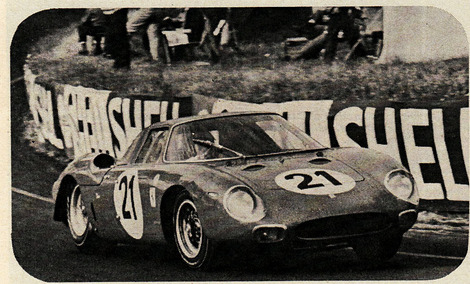 The beautiful 1963 Pininfarina 250 GT by Scaglietti. This car, often known as the "Lusso Berlinetta," is one of the most graceful of the touring Ferraris.
The beautiful 1963 Pininfarina 250 GT by Scaglietti. This car, often known as the "Lusso Berlinetta," is one of the most graceful of the touring Ferraris.
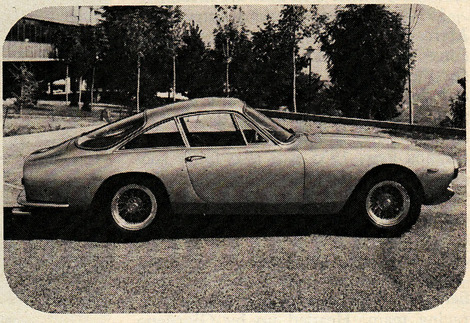 A tipo 250 LM. This particular car was entered by the North American Racing Team, Ferrari's racing arm in the U.S. The car was bored-out to 3286-cc's for more punch, and in the hands of Masten Gregory and Jochen Rindt it won the 1965 Le Mans.
A tipo 250 LM. This particular car was entered by the North American Racing Team, Ferrari's racing arm in the U.S. The car was bored-out to 3286-cc's for more punch, and in the hands of Masten Gregory and Jochen Rindt it won the 1965 Le Mans.
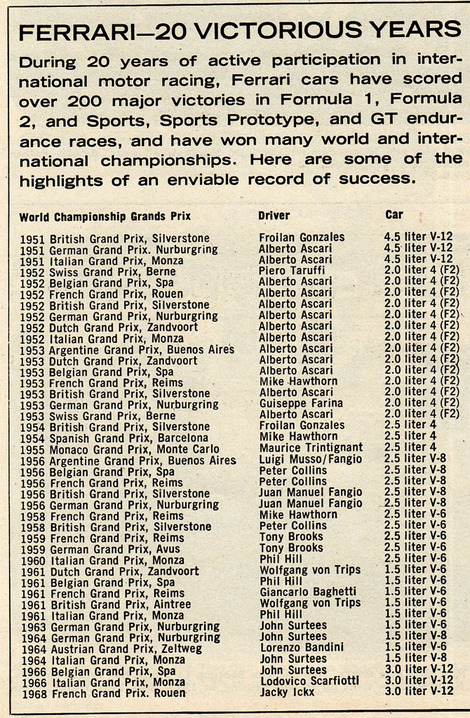
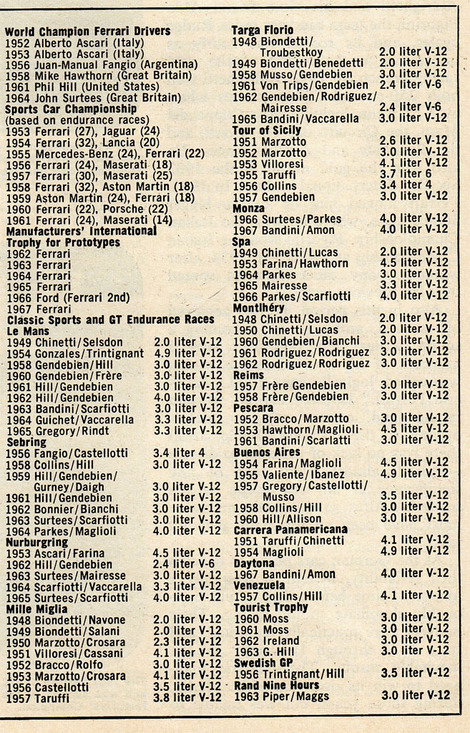
But these cars were Alfas and they had a new competitor in racing, through his old name. Immediately after the war, Enzo Ferrari began building formula cars. Beginning with 12-cylinder, 1500-cc supercharged Formula II cars, Ferrari was plagued with usual development problems, notably a rash of transmission failures.
In 1948 and 1949, the small Ferraris showed potential and set several lap records, but victory still eluded them. The Alfas, for which, ironically, Ferrari was in good part responsible, were winning everything.
In 1950, Ferrari decided to try something different. The Formula I in effect at the time allowed 4.5 liters if the engine was unsupercharged so Ferrari began development on a 3.3-liter engine, first bringing it out to 4.1 liters and, finally, to the full 4.5 liters. After winning several major races in absence of Alfa, the stage was set for an all-out confrontation. At the 1951 Berne Grand Prix, Ferrari's ace driver Alberto Ascari, was suffering from burns received in a Formula II crash and was off his form. Villoresi crashed in the race, so the honor of Ferrari was left to Taruffi, who could only manage a second behind Fangio's Alfa. Again at Spa and Rheims, the Alfa outdistanced the Ferrari, but the gap was rapidly closing.
At the 1951 Silverstone, Gonzales took his Ferrari around a full second faster than Fango's Alfa, and it looked like something was up. From the beginning of the race Fangio and Gonzales went at it with everything they had, but when Fangio had to stop to refuel (the unsupercharged Ferrari getting far better milage), the issue was decided once and for all. Alfa had been defeated and, though Fangio won the World Championship on Alfa that year with a win at Barcelona, Alfa had been throughly humiliated a second time at Monza. With their 1951 World Championship in hand, Alfa gracefully withdrew from racing, for it was obvious that the future was Ferraari's.
From that point on to the present, Ferrari' has always been a name to contend with. Its winning Le Mans every year between 1960 and 1965, together with winning Sebring six of the seven years between 1958 (the first year of the World Manufacturers' Sports Car Championship) and 1964, probably gave the marque more notoriety in the U.S. than their Grand Prix performances, but Ferrari has had grat success in every category it has entered. In Formula I, Ferrari has been World Champion in 1952, 1953, 1956, 1958, 1961 and 1964. Like Bentley, Bugatti, Mercedes, and Alfa before it, Ferrari has simultaneously set the standard for high speed touring cars. And it all began 50 years ago in the dead of winter when a sad young man decided that Fiat Motors didn't know what they had lost. Enzo Ferrari had never been more correct.
 1967 Formula I Ferrari as it appeared at Watkins Glen. Chris Amon driving. Ferrari placed fourth in the Formula I Manufacturers' Championship in 1967, has a good shot at 1968 title at this writing.
1967 Formula I Ferrari as it appeared at Watkins Glen. Chris Amon driving. Ferrari placed fourth in the Formula I Manufacturers' Championship in 1967, has a good shot at 1968 title at this writing.
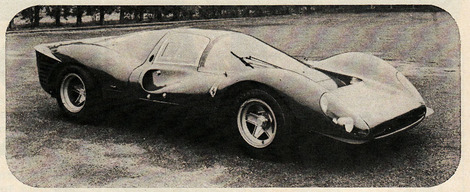 The beautiful Tipo 330 P4. THis car won the World Manufacturers Championship for sports cars in 1967 against stiff opposition from Porsche. Winning Daytona and Monza and placing second at Le Mans and Brands Hatch, it took second in the publicity department to Ford Mk IV's, which won at Sebring (uncontended) and Le Mans. Both cars were retired with FIA's new 3-liter limit on prototypes.
The beautiful Tipo 330 P4. THis car won the World Manufacturers Championship for sports cars in 1967 against stiff opposition from Porsche. Winning Daytona and Monza and placing second at Le Mans and Brands Hatch, it took second in the publicity department to Ford Mk IV's, which won at Sebring (uncontended) and Le Mans. Both cars were retired with FIA's new 3-liter limit on prototypes.
A short film
Here's a P3 in action
A Testa Rossa 250 at Goodwood 2005
More Testa Rossa
Here is a comprehensive list of Ferraris:
Models Until the early 1980s, Ferrari followed a three-number naming scheme based on engine displacement:
â–ª V6 and V8 models used the total displacement (in decilitres) for the first two digits and the number of cylinders as the third. Thus, the 206 was a 2.0Â L V6 powered vehicle, while the 348 used a 3.4Â L V8, although, for the F355, the last digit refers to 5 valves per cylinder. Upon introduction of the 360 Modena, the digits for V8 models (which now carried a name as well as a number) refer only to total engine displacement. The numerical indication aspect of this name has carried on to the current V8 model, the F430.
â–ª V12 models used the displacement (in cubic centimetres) of one cylinder. Therefore, the famed 365 Daytona had a 4390Â cc V12. However, some newer V12-engined Ferraris, such as the 599, have three-number designations that refer only to total engine displacement. â–ª Flat 12 (boxer) models used the displacement in litres. Therefore, the 512BB was five litre flat 12 (a Berlinetta Boxer, in this case). However, the original Berlinetta Boxer was the 365 GT4 BB, which was named in a similar manner to the V12 models. â–ª Some models, such as the 1980 Mondial and the 1984 Testarossa did not follow a three-number naming scheme.
612 Scaglietti Sessanta Edition Most Ferraris were also given designations referring to their body style. In general, the following conventions were used: â–ª M ("Modificata"), placed at the end of a model's number, denotes a modified version of its predecessor and not a complete evolution (see F512M and
575M Maranello). â–ª GTB ("Gran Turismo Berlinetta") models are closed Berlinettas, or coupes. â–ª GTS ("Gran Turismo Spyder") in older models, are open Spyders (spelt "y"), or convertibles (see 365GTS4); however, in more recent models, this suffix is used for targa top models (see Dino 246GTS, and F355 GTS; the exception being the 348 TS, which is the only targa named differently). The convertible models now use the suffix "Spider" (spelt "i") (see F355 Spider, and 360 Spider).
This naming system can be confusing, as some entirely different vehicles used the same engine type and body style. Many Ferraris also had other names affixed (like Daytona) to identify them further. Many such names are actually not official factory names. The Daytona name commemorates Ferrari's triple success in the February 1967 24 Hours of Daytona with the 330P4[5]. Only in the 1973 Daytona 24 Hours, a 365 GTB4 model run by NART, who raced Ferrari's in America) ran second, behind a Porsche 911[6].
The various Dino models were named for Enzo's son, Dino Ferrari, and were marketed as Dinos by Ferrari and sold at Ferrari dealers -- for all intents and purposes they are Ferraris. In the mid 1990s, Ferrari added the letter "F" to the beginning of all models (a practice abandoned after the F512M and F355, but adopted again with the F430).
Sports cars Ferrari's first models were sports/racing cars quite different from the grand touring models that followed. See below for a complete list.
2-seat Gran Turismo
Ferrari quickly moved into the Gran Turismo market, and the bulk of the company's sales remain in this area. â–ª 1949 166 Inter â–ª 1950 195 Inter â–ª 1951 212 Inter â–ª 1951 342 America â–ª 1953 375 MM â–ª 1953 250 Europa â–ª 1953 375 America â–ª 1954 250 Europa GT â–ª 1956 410 Superamerica â–ª 1956-1963 250 GT Europa/Boano/Ellena/Pininfarina Coupe/Lusso â–ª 1957-1960 250 GT Berlinetta/Cabriolet/California Spyder/SWB â–ª 1960 400 Superamerica â–ª 1964-1968 275 â–ª 1964-1965 275 GTB Coupe â–ª 1964-1965 275 GTS Spyder â–ª 1966-1968 275 GTB/4 â–ª 1964 500 Superfast â–ª 1964 330 â–ª 1966 330 GTC Coupe â–ª 1966 330 GTS Spyder â–ª 1966 365 California â–ª 1968 365 â–ª 1968-1969 365 GTC Coupe â–ª 1969-1970 365 GTS Spyder â–ª 1968-1973 365 Daytona â–ª 1968 365 GTB/4 Coupe â–ª 1968 365 GTS/4 Spyder â–ª 1996-2001 550 Maranello â–ª 1996-2001 550 Maranello â–ª 2001 550 Barchetta â–ª 2002-2006 575M Maranello â–ª 2002-2006 575M Maranello â–ª 2005 575M Superamerica â–ª 2007 599 GTB Fiorano
Mid-engine V6/V8
328GTS Targa
The Dino was the first mid-engined Ferrari. This layout would go on to be used in most Ferraris of the 1980s and 1990s. V6 and V8 Ferrari models make up well over half of the marque's total production. â–ª 1968-1974 Dino â–ª 1968-1969 Dino 206 GT â–ª 1969-1974 246GT Berlinetta, or Coupe â–ª 1972-1974 246GTS (targa top) Spyder â–ª 1975-1989 208/308/328 GTB/GTS â–ª 1975-1977 308 GTB (GRP) â–ª 1977-1979 308 GTB and GTS â–ª 1980-1981 208 GTB & GTS â–ª 1980-1981 308 GTBi & GTSi â–ª 1982-1985 208 GTB/GTS Turbo â–ª 1982-1985 308 GTB/GTS Quattrovalvole â–ª 1986-1989 328 GTB & GTS â–ª 1986 208 GTB/GTS Turbo â–ª 1989-1994 348 â–ª 1989-1993 348 TB & TS â–ª 1993-1994 348 GTB, GTS & Spider â–ª 1994-1999 F355 â–ª 1994-1999 F355 Berlinetta & GTS â–ª 1995-1999 F355 Spider â–ª 1995 F355 Challenge â–ª 1998-1999 355 F1 â–ª 1999-2004 360 â–ª 1999-2004 360 Modena & Spider â–ª 2003-2004 360 Challenge Stradale â–ª 2005 F430 â–ª 2005 F430 & F430 Spider â–ª 2007 430 Scuderia â–ª 2009 Scuderia Spider 16M
Mid-engine 2+2
Bertone-bodied Dino 308 GT4
For a time, Ferrari built 2+2 versions of its mid-engined V8 cars. Although they looked quite different from their 2-seat counterparts, both the GT4 and Mondial were closely related to the 308 GTB. â–ª 1974-1980 208/308 GT4 â–ª 1974-1975 Dino 308 GT4 â–ª 1976-1980 308 GT4 â–ª 1975-1980 208 GT4 â–ª 1980-1993 Mondial â–ª 1980-1981 Mondial 8 â–ª 1982-1985 Mondial QV (Quattrovalvole) Coupe â–ª 1983-1985 Mondial QV Cabriolet â–ª 1985-1989 3.2 Mondial Coupe & 3.2 Mondial Cabriolet â–ª 1989-1993 Mondial T Coupe & Mondial T Cabriolet
Front-engine 2+2
612 Scaglietti
The company has also produced front-engined 2+2 cars, culminating in the current 612 Scaglietti and upcoming California. â–ª 1960-1963 250 â–ª 1960-1963 250 GT/E 2+2 â–ª 1964-1967 330 â–ª 1964-1965 330 GT 2+2 â–ª 1965-1967 330 GT 2+2 Mk II â–ª 1967-1971 365 â–ª 1967-1971 365 GT 2+2 â–ª 1968-1973 365 Daytona â–ª 1971-1972 365 GTC/4 â–ª 1972-1976 365 GT4 2+2 â–ª 1976-1989 400 & 412 â–ª 1976 400 Automatic â–ª 1979 400i â–ª 1985 412 â–ª 1992-2003 456 & 456 M â–ª 1992-1997 456 GT & GTA Coupe â–ª 1998-2003 456 M GT & M GTA Coupe â–ª 2004 612 Scaglietti â–ª 2009 Ferrari California
Mid-engine 12-cylinder
Ferrari entered the mid-engined 12-cylinder fray with the Berlinetta Boxer in 1973. The later Testarossa remains one of the most famous Ferraris. â–ª 1973-1984 Berlinetta Boxer â–ª 1973-1976 365 GT4 BB â–ª 1976-1981 512 BB â–ª 1981-1984 512i BB â–ª 1984-1996 Testarossa â–ª 1984-1992 Testarossa â–ª 1992-1994 512 TR â–ª 1994-1996 F512 M
Supercars
Enzo Ferrari
The company's loftiest efforts have been in the supercar market. â–ª 1962-1964 250 GTO â–ª 1984-1985 288 GTO â–ª 1987-1992 F40 â–ª 1995-1997 F50 â–ª 1996 F50 GT â–ª 2003-2005 Enzo â–ª 2006 FXX
Competition cars
Current â–ª 2009 F60 â–ª 2007 599 GTB Fiorano â–ª 2006-2008 Ferrari F430 â–ª 2006 F430 GT â–ª 2006 F430 Pista â–ª 2006 FXX
Past
1958 250 Testa Rossa from the Ralph Lauren collection â–ª Sports cars â–ª 1940 AAC 815 â–ª 1947 125 Sport â–ª 1947 159 Sport â–ª 1948 166 S/SC/MM â–ª 1950 195 S â–ª 1951 340 America â–ª 1951 212 Export â–ª 1952 225 S â–ª 1952 250 S â–ª 1952 340 Mexico â–ª 1953 250 MM â–ª 1953 Ferrari-Abarth 166 MM/53 â–ª 1953 625 TF â–ª 1953 735 S â–ª 1953 500 Mondial â–ª 1953 340 MM â–ª 1953 375 MM â–ª 1954 750 Monza â–ª 1954 250 Monza â–ª 1954 375 Plus â–ª 1955 118 LM â–ª 1955 121 LM â–ª 1955 410 S â–ª 1955 857 S â–ª 1956 500 TR â–ª 1956 290 MM â–ª 1956 290 S â–ª 1956 860 Monza â–ª 1956 625 LM â–ª 1957 500 TRC â–ª 1957 315 S â–ª 1957 335 S â–ª 1957 250 Testa Rossa â–ª 1958 412S[7] â–ª 1960 250 TR60/61
1962 Ferrari 250 GTO. â–ª 1962 250 GTO â–ª 1964 250 GTO â–ª 1963 330 LM Berlinetta â–ª 1963 P/LM series â–ª 1963 250 P â–ª 1964 250 LM â–ª 1964 330 P â–ª 1965 330 P2 â–ª 1966 330 P3 â–ª 1967 330 P4 â–ª 1967 412 P â–ª 1969 Ferrari 212 E "Montagna" â–ª 1969 312 P â–ª 1969 512 S and 512 M â–ª 1971 312 PB â–ª 1979 Ferrari 512 BB LM â–ª 1987 Ferrari GTO Evoluzione â–ª 1987 F40 â–ª CSAI-GT â–ª 1988 LM â–ª GT â–ª GTE â–ª 1994 333 SP â–ª 1995 F50 GT â–ª 360 â–ª 2002 360 GT â–ª 2004 360 GTC â–ª 2005 FXX
Formula 1
â–ª 1948 125 F1
â–ª 1950 275 F1
â–ª 1950 340 F1
â–ª 1950 375 F1
â–ª 1954 553 F1
â–ª 1954 625 F1
â–ª 1955 555 F1
â–ª 1955 Ferrari-Lancia D50
â–ª 1957 801 F1
â–ª 1958 412 MI
â–ª 1958 246 F1
â–ª 1959 256 F1
â–ª 1961 156 F1
â–ª 1964 158 F1
â–ª 1964 512 F1
â–ª 1966 312 F1
â–ª 1970 312 B
â–ª 1971 312 B2
â–ª 1973 312 B3
â–ª 1975 312 T
â–ª 1976 312 T2
â–ª 1978 312 T3
â–ª 1979 312 T4
â–ª 1980 312 T5
â–ª 1981 126 C
â–ª 1982 126 C2
â–ª 1983 126 C3
â–ª 1984 126 C4
â–ª 1985 156/85
â–ª 1986 F1/86
â–ª 1987 F1/87
â–ª 1988 F1/88
â–ª 1989 F1 640
â–ª 1990 F1 641
â–ª 1991 F1 642
â–ª 1991 F1 643
â–ª 1992 F 92 A
â–ª 1993 F 93 A
â–ª 1994 412 T1/T1B
â–ª 1995 412 T2
â–ª 1996 F 310
â–ª 1997 F 310 B
â–ª 1998 F 300
â–ª 1999 F 399
â–ª 2000 F1-2000
â–ª 2001 F2001
â–ª 2002 F2002
â–ª 2003 F2003-GA
â–ª 2004 F2004
â–ª 2005 F2005
â–ª 2006 248 F1
â–ª 2007 F2007
â–ª Formula 2
â–ª 1948 125 F2
â–ª 1951 500 F2
â–ª 1953 553 F2
â–ª 1957 Dino 156 F2
â–ª 1967 Dino 166 F2
Concept models and one-off specials â–ª 1949 Ferrari 166 MM Zagato Panoramica â–ª 1952 Ferrari 250 S Vignale Coupe â–ª 1954 Ferrari 375 MM "Ingrid Bergman" â–ª 1956 Ferrari 250GTZ â–ª 1962 Ferrari 250 GT Drogo â–ª 1966 Ferrari 365 P Pininfarina Speciale â–ª 1968 Ferrari 250 P5/P6 â–ª 1968 Ferrari Dino Berlinetta â–ª 1969 Ferrari Sigma Grand Prix â–ª 1969 Ferrari 365 GT Nart Spyder â–ª 1969 Ferrari Pininfarina 512S Berlinetta Speciale â–ª 1970 Ferrari Modulo 512 â–ª 1971 Ferrari 3Z Spider â–ª 1972 Ferrari 365 GTB/4 Daytona Competizione Spyder â–ª 1975 Ferrari 365 GTS/4 Michelotti NART Spyder â–ª 1975 Ferrari 365 GTB/4 Shooting Break â–ª 1980 Ferrari Pinin â–ª 1987 Ferrari 408 â–ª 1989 Ferrari Mythos â–ª 1989 Colani Ferrari Testa d'Oro â–ª 1990 Ferrari 348 Zagato Elaborazione â–ª 1993 Ferrari FZ93 â–ª 1995 Ferrari FX â–ª 1996 Ferrari F50 Bolide â–ª 2005 Ferrari GG50 â–ª 2005 Ferrari Ascari â–ª 2006 Ferrari P4/5 â–ª 2006 Ferrari Zagato 575 GTZ â–ª 2006 Ferrari Rossa â–ª 2008 Ferrari SP1 â–ª 2010 millechili[8] â–ª 2010 Ferrari F151
Here are a three in a series of twelve I took of a Ferrari F 40 at Road America you can view full set under automotive collections.
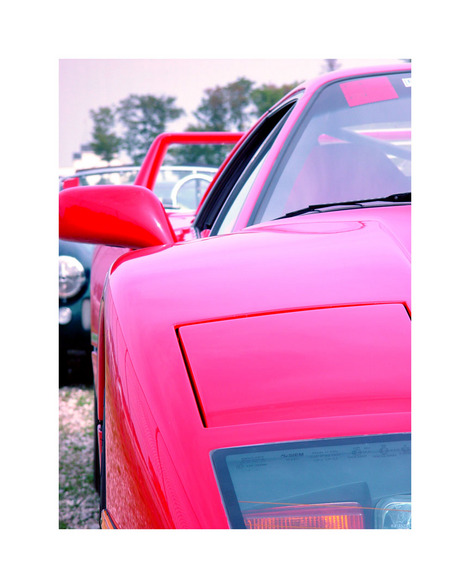
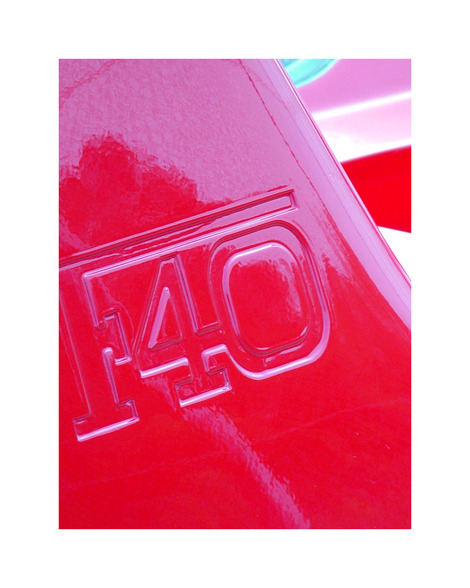
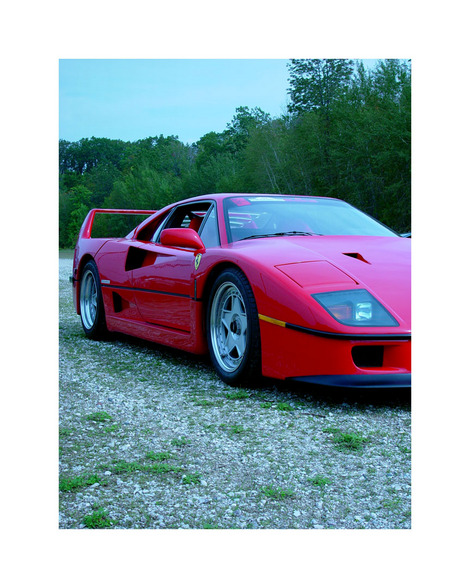
An F 40 race prepared
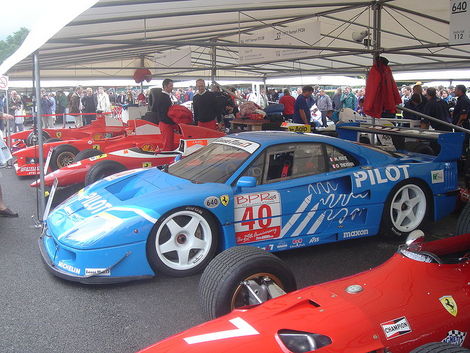
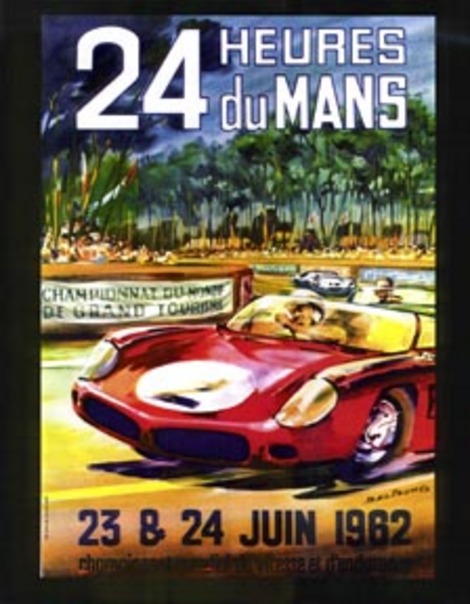 Le Mans poster of the time.
Le Mans poster of the time.
A Barchetta
1958 250 Testa Rossa
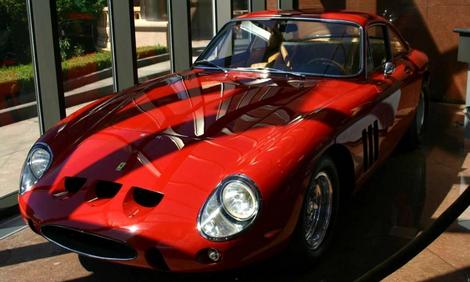 1962 Ferrari
1962 Ferrari
Series of photos of 330 P4 - I find one of the most beautiful cars ever designed - truly breath taking.
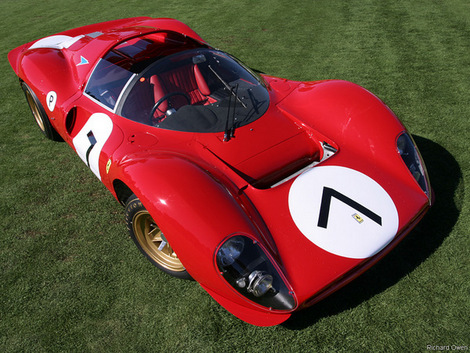
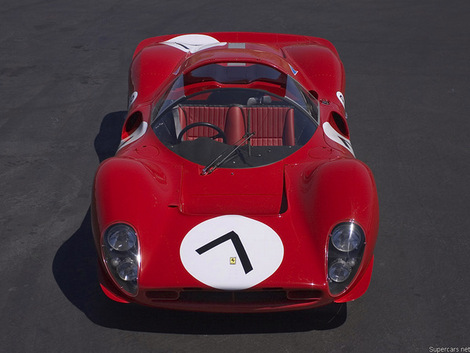
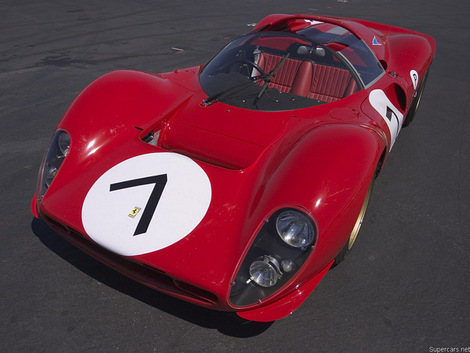
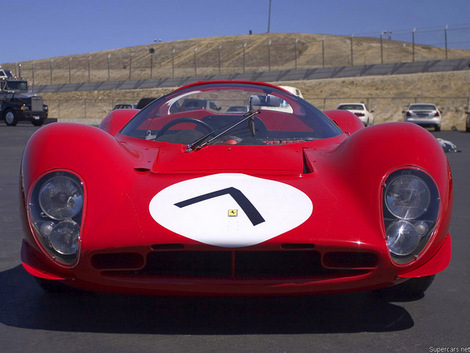
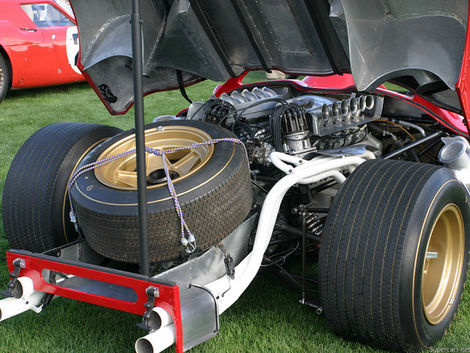
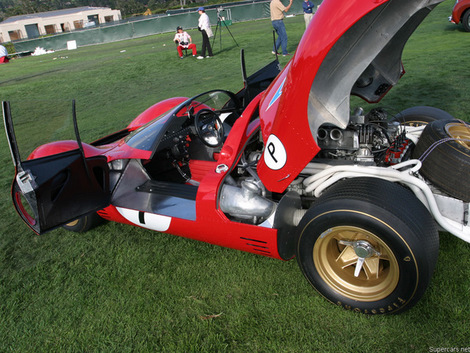
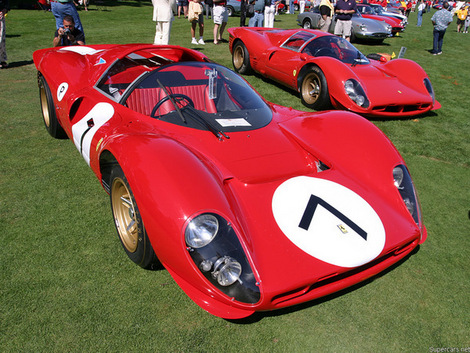
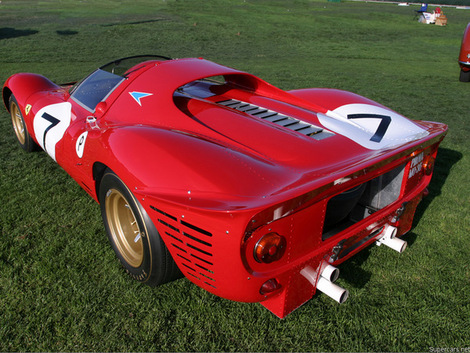
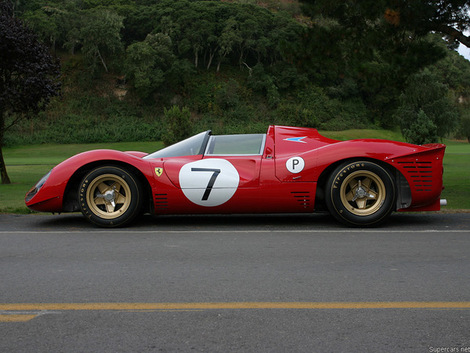
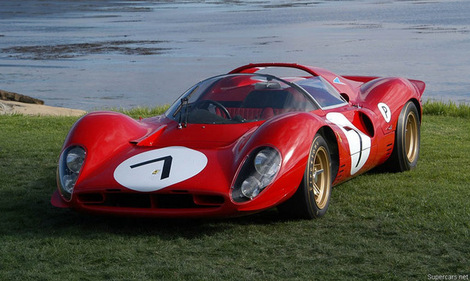
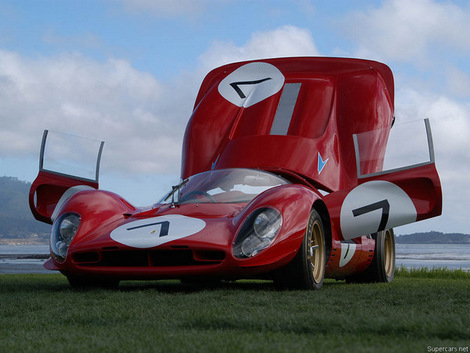
Finally a beautiful Enzo
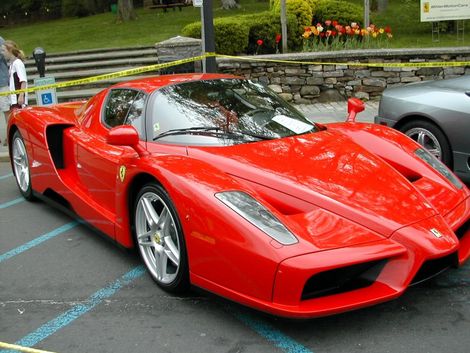
Ferraris are the car everyone wants to own and few of us ever will. As close as I will ever come is driving one. They are as expensive as they are beautiful.
Posted 02/28/09 @ 08:06 PM | Tags: Ferrari, Enzo Ferrari, Diego Soria, Fiat Motor Company, 1934 Coppa Del Mare, 1924 French Grand Prix, 1919 Targa Florio, Giuseppe Campari, Luigi Bazzi, Vittorio Jano, Mercedes, Pescara, Alfa Romero, Bugatti, Maserati, Alberto Ascari, Marchese Lotario Rangoni Machiavelli, Fifty Years of Ferrari, Dino Ferrari, Scuderia Ferrari, Mille Miglia, Varzi, Targo Florio, Alfa 2650 P3, Carraciola, Lancia, Borzacchini, Spa, LeMans, Grand Prix of Finland, Grand Prix of Mareilles, Monza, German Grand Prix, Grand Prix of Avellino, Nuvolari, Auto Union, Rudge Motorcycles, Giordano Aldrighetti, Aldo Pigorini, 1963 Ininfarina 250 GT by Scaglietti, Tipo 250 LM, 24 hours of Sebring, tipo 330 P4, Sports Car Graphic November 1968, Sports Car Graphic magazine